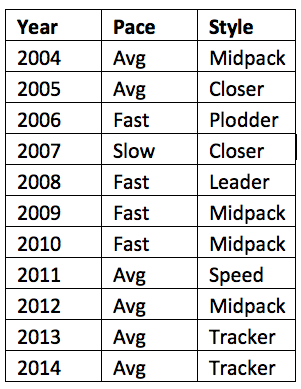
By TimeformUS Chief Figure Maker Craig Milkowski
There are many ideas floating around about how to analyze the Belmont Stakes for handicapping purposes. Some believe the longer distance favors those making a late charge. Others think that those near the front have an advantage. TimeformUS has Pace and Speed figures for the Belmont Stakes going back through 2004. It isn’t a sample size a statistician would consider sufficient, but it’s worth a look, if only to dispel some of the sillier notions that are out there.
Speed Figures
- The average winning TimeformUS Speed Figure for the Belmont Stakes is 115. This does not compare well with the other two legs of the Triple Crown races. The Kentucky Derby averages 121 and the lowest winning figure in the last 12 years was Giacomo’s 115 in 2005. The Preakness is higher still, with a 123 average and a low of 118 — Big Brown’s 2008 win.
- This isn’t without reason. Obviously, horses are rarely bred with the Belmont Stakes in mind–The distance is longer than most will ever be asked to run again.
- Only twice in the past 11 years has the Belmont Stakes TimeformUS Speed Figure been greater than (or even equal to) that of the corresponding Kentucky Derby. It occurred in 2004, when Birdstone’s 123 surpassed Smarty Jones’s 121. It happened again in 2005, when Afleet Alex ran a 117 winning the Belmont after Giacomo ran a 115 in Kentucky.
- The Preakness Stakes’ winning TimeformUS Speed Figure has been at least three points higher than the corresponding Belmont Stakes each year. The moral of this story? Don’t expect speed figures from the Derby and Preakness to be matched in the Belmont Stakes. Newcomers to the Triple Crown series don’t need to match Derby/Preakness figures to be considered contenders.
Running Styles and Race Shapes
- Racehorses that can adapt to pace scenarios have an advantage over those that always run one way. Some horses are “need the lead” while others are stone-cold closers that have no early speed. Most, however, are more versatile. TimeformUS gives each horse a running style label based on past results. There is no guarantee that the horse will cooperate in future races. The following table displays the pace of the race, based on TimeformUS Pace Figures, and the running style of the winner for each Belmont Stakes since 2004:

The results of the prior 11 Belmont Stakes do not favor any particular running style. Horses have won from all different positions early. Only once in these 11 years was the pace considered slow and that race was won by Rags to Riches from off the pace after a poor start. The one time a horse labeled as “Leader” won (Da’ Tara in 2008), the pace was fast.
Conclusion
The Belmont Stakes is a unique race, 12 furlongs on dirt, and as such it should not be surprising that traditional handicapping methods do not work very well. The most solid conclusion that can be drawn is that the pace will be average-to-fast; it has been slow only once in the last 11 runnings of the race. Pace analysis generally favors speed horses when the pace is slow and off-pace runners when the pace is fast. But those rules do not appear to apply to the Belmont. Likewise, speed figures earned in races at distances spanning nine to 10 furlongs rarely indicate what a horse can run at 12 furlongs, just as a six furlong speed figure doesn’t mean all that much at a mile. Our recommendation for the Belmont Stakes? Be creative. Consider pace analysis and speed figures, but emphasize breeding, trainers, and form cycles. Good luck!
related:





